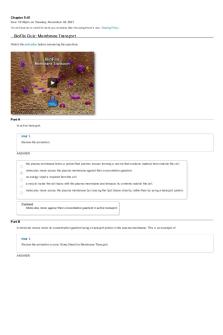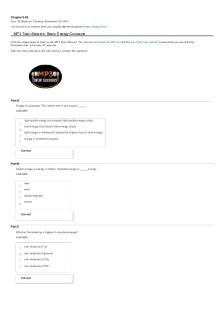Review chapter 5 2012 - Homework PDF

| Title | Review chapter 5 2012 - Homework |
|---|---|
| Author | Devin Harris |
| Course | Enviro Bio-Sw Fla Environment |
| Institution | Florida Gulf Coast University |
| Pages | 2 |
| File Size | 96.3 KB |
| File Type | |
| Total Downloads | 3 |
| Total Views | 120 |
Summary
Homework...
Description
Environmental Biology Chapter 5 Review Biodiversity, Species Interactions, and Population Control 1.
Discuss the history and biology of sea otters.
2. 3. 4. 5. 6. 7. 8.
Define interspecific competition and give an example. What is resource partitioning? Provide an example. PredationDescribe the predator-prey relationship. Illustrate the concept with local examples. Why are predators important to the health of the prey populations? What are some of the ways prey avoid predators? Use local examples for each method. Coevolution- Give the definition and an example.
9. 10. 11. 12.
What is Symbiosis? Use a dictionary if you need to. Parasitism – Commensalism – Mutualism –
13. 14. 15. 16. 17. 18. 19. 20. 21. 22. 23. 24. 25.
Discuss the 3 ways populations are dispersed in the environment. What 4 variables determine population size? Each population has a range of tolerance in relation to what? What is the “limiting factor principal”? Define environmental resistance and carrying capacity. What happens if the population size exceeds the carrying capacity? What is overshoot? Give an example of a density-independent population control. Give an example of a density-dependent population control. What are the four general patterns of variation in population size? What are the two different reproductive patterns that species have? Which group would most likely be found in a stable ecosystem? Which group would most likely be found in a disturbed ecosystem?
26. 27. 28.
What is ecological succession? Primary succession – Secondary succession -
1. Sea otters play an important role in maintaining the health of the kelp ecosystem. The number the number of shellfish that feed on help, and they promote the development of kelps. Sea otters live along part of the Pacific coast of North America and they are keystone species. 2. Interspecific competition is when members of two or more species interact to gain access to the same limited resources such as food, water, light and space. 3. Resource partitioning is when species competing over the same resources, end of finding ways to share that same resource. 4. Predation is when a predator feeds directly on all or part of a living organism as part of a food web. 5. The predator-prey relationship is a relationship that has evolved between two organisms. One example would be the bear and the cutworm moth: the bear eats the cutworm moth, and the cutworm moth has nutrients that the bear can store in its fatty tissues to draw on during hibernation periods. 6. Predators are important because predators help slow down the spread of disease due to overpopulation. 7. Some ways prey avoid predators is by camouflage, aposematic coloration, and clumping. Local examples would be like the walking stick, a skunk, and zebras. 8. Coevolution is an evolutionary change between two or more species. An example would between bats and certain moth species: the bat makes sounds to call the prey and the prey responds back informing the bat of its location. 9. Symbiosis is a long term relationship between two or more species. 10. Parasitism is when one organism feeds on the host and benefits from it. 11. Commensalism is an interaction that benefits one species but has little beneficial effect on the other. 12. Mutualism is when two species behave in ways that benefit both by providing each with food. 13. They are dispersed through random and clumping, top to bottom, and uniform. 14. Population size is determined by births, deaths, immigration, and emigration. 15. Each population has a range of tolerance in relation to the number of individuals. 16. The limiting factor principle is when too much or too little of any physical or chemical factor can limit or prevent growth of a population. 17. Environmental resistance is the combination of all factors that act to limit the growth of a population. Carrying capacity the maximum population of a given species that a particular habitat can sustain indefinitely. 18. If a population exceeds the carrying capacity, populations tend to die out and crash. 19. Overshoot is when you control the carrying capacity of an environment. 20. An example of density-independent population control would be something like drought in a pond. 21. An example of density-dependent population control would something like parasitism. 22. The four general patterns are stable, irruptive, cyclic, and irregular. 23. Two different reproductive patterns species have are j-curves and s-curves. 24. Groups of large mammals like rhinos would show in a stable ecosystem. 25. A group most likely in a disturbed ecosystem would be a tropical forest. 26. An ecological succession is the normal gradual changes in a species composition in a given area. 27. Primary succession is the gradual establishment of biotic communities in lifeless areas where there is no soil in a terrestrial ecosystem or no bottom sediment in an aquatic ecosystem. 28. Secondary succession is when a series of communities or ecosystems with different species develop in places containing soil or bottom sediment....
Similar Free PDFs

Review chapter 5 2012 - Homework
- 2 Pages

Chapter 5 HW - Homework
- 2 Pages

Homework Chapter 5
- 4 Pages

Chapter 5 LAB Homework
- 20 Pages

Chapter 5 Accounting homework
- 4 Pages

Chapter 5 Homework - Solutions
- 3 Pages

Chapter 5 Homework solution
- 16 Pages

Chapter 1 Test Review - homework
- 6 Pages

Chapter 5 Review Questions
- 5 Pages

Chapter 5 review answers
- 5 Pages

Chapter 5-01 - Pearson - Homework
- 13 Pages

Chapter 5-02 - Pearson - Homework
- 16 Pages

Chapter 5 Review Questions
- 4 Pages

Chapter 5 review questions
- 2 Pages

Chapter 5 Review Questions
- 3 Pages

Chapter 5 Exam Review
- 5 Pages
Popular Institutions
- Tinajero National High School - Annex
- Politeknik Caltex Riau
- Yokohama City University
- SGT University
- University of Al-Qadisiyah
- Divine Word College of Vigan
- Techniek College Rotterdam
- Universidade de Santiago
- Universiti Teknologi MARA Cawangan Johor Kampus Pasir Gudang
- Poltekkes Kemenkes Yogyakarta
- Baguio City National High School
- Colegio san marcos
- preparatoria uno
- Centro de Bachillerato Tecnológico Industrial y de Servicios No. 107
- Dalian Maritime University
- Quang Trung Secondary School
- Colegio Tecnológico en Informática
- Corporación Regional de Educación Superior
- Grupo CEDVA
- Dar Al Uloom University
- Centro de Estudios Preuniversitarios de la Universidad Nacional de Ingeniería
- 上智大学
- Aakash International School, Nuna Majara
- San Felipe Neri Catholic School
- Kang Chiao International School - New Taipei City
- Misamis Occidental National High School
- Institución Educativa Escuela Normal Juan Ladrilleros
- Kolehiyo ng Pantukan
- Batanes State College
- Instituto Continental
- Sekolah Menengah Kejuruan Kesehatan Kaltara (Tarakan)
- Colegio de La Inmaculada Concepcion - Cebu